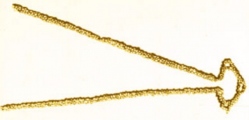<< Our Photo Pages >> Shahmon Desert Kite - Misc. Earthwork in Israel
Submitted by motist on Monday, 30 March 2009 Page Views: 8645
Multi-periodSite Name: Shahmon Desert KiteCountry: Israel
NOTE: This site is 2.767 km away from the location you searched for.
Type: Misc. Earthwork
Nearest Town: Eilat Nearest Village: Kibutz Eilot
Latitude: 29.584660N Longitude: 34.947267E
Condition:
| 5 | Perfect |
| 4 | Almost Perfect |
| 3 | Reasonable but with some damage |
| 2 | Ruined but still recognisable as an ancient site |
| 1 | Pretty much destroyed, possibly visible as crop marks |
| 0 | No data. |
| -1 | Completely destroyed |
| 5 | Superb |
| 4 | Good |
| 3 | Ordinary |
| 2 | Not Good |
| 1 | Awful |
| 0 | No data. |
| 5 | Can be driven to, probably with disabled access |
| 4 | Short walk on a footpath |
| 3 | Requiring a bit more of a walk |
| 2 | A long walk |
| 1 | In the middle of nowhere, a nightmare to find |
| 0 | No data. |
| 5 | co-ordinates taken by GPS or official recorded co-ordinates |
| 4 | co-ordinates scaled from a detailed map |
| 3 | co-ordinates scaled from a bad map |
| 2 | co-ordinates of the nearest village |
| 1 | co-ordinates of the nearest town |
| 0 | no data |
Internal Links:
External Links:
Excavation that took place in October 1993, 1994 which gave C14 date from an olive seed found in the upper layer to the 16 -17 century BCE. A thermoluminescence test from the wall in the bottom the depression gave a date of 3500+- 500 years BCE.
The excavators are Dr. Uzi Avner and Asaff Holtzer.
See our article Desert Kites for more information.
Note: Ancient Hunting Techniques Revealed. See Comment.
You may be viewing yesterday's version of this page. To see the most up to date information please register for a free account.

















Do not use the above information on other web sites or publications without permission of the contributor.
Click here to see more info for this site
Nearby sites
Click here to view sites on an interactive map of the areaKey: Red: member's photo, Blue: 3rd party photo, Yellow: other image, Green: no photo - please go there and take one, Grey: site destroyed
Download sites to:
KML (Google Earth)
GPX (GPS waypoints)
CSV (Garmin/Navman)
CSV (Excel)
To unlock full downloads you need to sign up as a Contributory Member. Otherwise downloads are limited to 50 sites.
Turn off the page maps and other distractions
Nearby sites listing. In the following links * = Image available
2.6km NNE 31° Arround Shchoret hills* Ancient Village or Settlement
2.6km WNW 292° Wadi Tawahin* Ancient Mine, Quarry or other Industry
2.8km NNE 13° Shehoret Hills Desert Kite* Misc. Earthwork
3.1km NNE 17° Shchoret hills Open Air Mosque* Ancient Temple
3.3km N 360° Shchoret habitation site* Ancient Village or Settlement
3.3km NW 320° Yedidyah pass Roded type cult site* Ancient Village or Settlement
3.4km NW 305° Wadi Roded Open Air Sanctuaries* Ancient Temple
3.9km WNW 295° Roded cult sites* Ancient Temple
6.1km SW 217° Ramat Yotam 'roded' type site* Ancient Temple
6.4km WNW 288° North of Netafim spring* Ancient Temple
6.8km W 278° Netafim Neolithic sanctuary* Ancient Temple
7.3km N 4° Mt. 'Amram Tumulus* Burial Chamber or Dolmen
8.9km NNW 344° Upper Wadi Racham Camp* Standing Stones
10.2km NW 319° Mount Uzia West Predators Trap* Misc. Earthwork
10.5km N 352° Wadi Racham Matsebah* Standing Stones
10.9km NNE 12° Nitsots hill open air sanctuary* Ancient Temple
11.6km NNW 339° North of Wadi Shani Masseboth* Standing Stones
12.2km N 353° S' of wadi 'Eteq* Ancient Temple
12.2km N 352° Flint workshop west of wadi Racham* Ancient Mine, Quarry or other Industry
12.9km NNW 346° Wadi 'Eteq Villas* Ancient Temple
13.0km SW 218° Wadi Tweiba* Rock Art
13.4km NNW 334° SE' Se'ipim valley* Ancient Village or Settlement
14.0km N 8° E' of wadi Racham * Ancient Temple
14.1km NNW 338° E' Se'ipim valley* Ancient Village or Settlement
14.4km N 10° Beer-Ora N* Ancient Temple
View more nearby sites and additional images



 We would like to know more about this location. Please feel free to add a brief description and any relevant information in your own language.
We would like to know more about this location. Please feel free to add a brief description and any relevant information in your own language. Wir möchten mehr über diese Stätte erfahren. Bitte zögern Sie nicht, eine kurze Beschreibung und relevante Informationen in Deutsch hinzuzufügen.
Wir möchten mehr über diese Stätte erfahren. Bitte zögern Sie nicht, eine kurze Beschreibung und relevante Informationen in Deutsch hinzuzufügen. Nous aimerions en savoir encore un peu sur les lieux. S'il vous plaît n'hesitez pas à ajouter une courte description et tous les renseignements pertinents dans votre propre langue.
Nous aimerions en savoir encore un peu sur les lieux. S'il vous plaît n'hesitez pas à ajouter une courte description et tous les renseignements pertinents dans votre propre langue. Quisieramos informarnos un poco más de las lugares. No dude en añadir una breve descripción y otros datos relevantes en su propio idioma.
Quisieramos informarnos un poco más de las lugares. No dude en añadir una breve descripción y otros datos relevantes en su propio idioma.